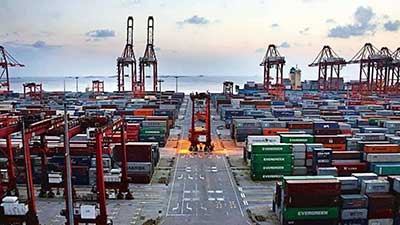Date: 30/12/2022
Relevance: GS-3: Effects of Liberalization on the Economy; Balance of Payment and Trade balance of India.
Key Phrases: Foreign Trade deficit, Export and Import, LPG Reforms, Institutional Setup, Regulatory Framework, Import Cover, Policy stability, Tariff and Non-Tariff Barrier, Developing Nations, Recession, Russia-Ukraine War.
Context:
- Recently, India’s goods exports rebounded from a nearly 17% dip in October to a mild 0.6% uptick in November.
- While the value of exports recovered to $32 billion from $29.8 billion in October, it is still significantly below the $39 billion averaged between April 2022 and September 2022.
Key Highlights:
- Imports growth moderated to 5.4% with the value of shipments slipping to $55.9 billion - a level last seen in February 2022, which was followed by seven months of import bills of around $60 billion.
- The merchandise trade deficit eased below $25 billion for the first time in five months.
- As per the recently released CARE Ratings research paper, having grown 11.1% in the first eight months of 2022-23, goods exports could still fall 2.3% over the full year.
- While the WTO expects global goods trade to grow just 1% in 2023, CARE expects India’s exports may rise 1.5% in 2023-24.
What are the Major Concerns for India’s Foreign Trade?
- Non-oil Exports’ Performance
- A part of the import bill dip was triggered by lower non-oil cargo,
signaling slowing domestic demand, but non-oil exports’ performance
is a greater worry.
- Their share in exports growth has been shrinking since June, with the contraction accelerating for many sectors from September to November- engineering goods that drove much of India’s record $422 billion goods exports in 2021-22, contracted 11.3% while textiles fell a steeper 25%.
- A part of the import bill dip was triggered by lower non-oil cargo,
signaling slowing domestic demand, but non-oil exports’ performance
is a greater worry.
- Key Markets heading towards Recession
- December’s pending festive orders may still lift export numbers month-on-month, but the onset of 2023 would spell greater pressures for India’s trade story, with key markets heading into a recession.
- Fall in the Export of Engineering Goods
- Engineering goods, which form a larger part of India's goods exports
in recent years, slid 21%.
- This slowdown is attributed to high inflation in developed regions, falling demand in China, slowdown in the EU and the U.S. and the Russia-Ukraine war.
- The Commerce Ministry explained that for October, a decline of $2 billion worth of exports was seen in steel and allied products because of removal of export duty which was levied on these products earlier.
- The Ministry also highlighted that in the month of Diwali every year, workers tend to take leave, thus impacting output.
- Engineering goods, which form a larger part of India's goods exports
in recent years, slid 21%.
- Not a Healthy Import Cover
- Import Cover measures the number of months of imports that can be covered with foreign exchange reserves available with the central bank of the country.
- For the week ended December 2, foreign exchange reserves stood at
about $561 billion.
- If we take October imports at $56.7 billion (an eight-month low) as a benchmark, then we have roughly about 9-10 months’ worth of import cover which isn’t as healthy as the 14-to-15-month cover that we had seen during the pandemic.
What about other exporting nations?
- Vietnam, an export-dominated country, recorded a 4.5% growth in exports from a year earlier to $29.18 billion amid ‘sustained foreign demand’.
- Similarly, exports by the Philippines grew 20% in October.
- The government there had said that exports rose for the first time in three months in September amid what it calls ‘signs of reviving foreign demand’.
- China is an outlier this year because of stringent lockdowns that are impacting manufacturing output.
Is domestic demand enough?
- The monthly Finance Ministry review for October acknowledges a
slowing export scenario but emphasizes that domestic demand will carry
through.
- The report states that the global slowdown is driven by a ‘confluence of stubbornly high inflation, rising borrowing costs and geopolitical tensions’, but cites local demand as being ‘resilient’.
Way Forward:
- The easing of some commodities’ prices may help curb the import bill and deficit to some extent, but this could cut both ways as the value of some exports that boomed because of global price trends earlier, will also decline.
- Services exports and remittance inflows may cushion India’s current account deficit from the goods trade imbalance and restrict the economy’s external vulnerabilities, but policy makers need to focus on ensuring a soft landing for factories in export-intensive sectors that are also massive employers so that the global gloom does not hit domestic sentiment.
- Vietnam, Cambodia, Bangladesh and China saw their share rise even when
global trade growth itself slowed in the years before COVID-19.
- India too, should aspire to emerge stronger from the brewing storm.
Conclusion:
- Keeping an eye on market realities to respond deftly to emerging challenges is vital for Indian exporters to sustain through the coming turmoil and perhaps, even expand their share in the global trade pie.
Source: The Hindu
Mains Question:
Q. What are the major concerns India is facing in the foreign trade? Also, suggest measures to address these concerns. (150 Words)






















